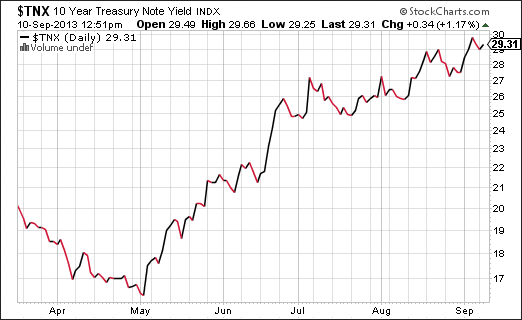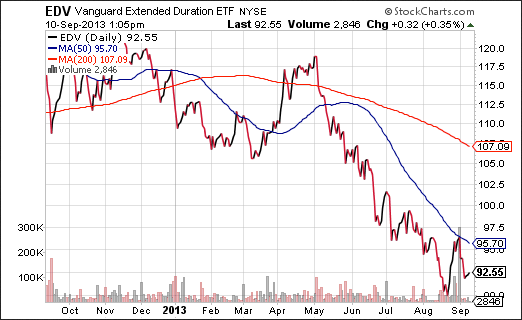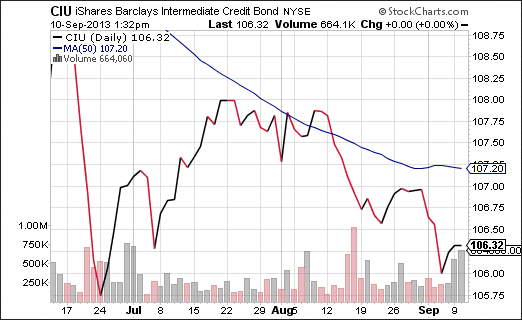Nearly 12 years of ultra-easy, unconventional monetary policy in Japan have led to some of the lowest yielding bonds in the world. Specifically, the Bank of Japan (BOJ) had hoped that — by printing yen — its currency would lose value such that export demand would increase. Moreover, by simultaneously using the new-found yen to purchase government debt obligations, the subsequent decline in yields would encourage borrowing and spending.
Here in 2013, however, it is difficult to see the success of Japan’s experimentation. In spite of a general trend of declining longer-term yields, the wages of Japanese workers have been stagnant for more than a decade. Of course, any debts that those employees hold are mostly fixed, leaving each with less money to live on annually. Similarly, if wages fall and if prices of goods fall because businesses need to sell inventory — a condition called deflation — the result is an economy stuck in neutral or worse.
While any comparison between the United States and Japan is suspect, the similarities should not be ignored either. For example, wage deflation has been a significant challenge for the U.S. Federal Reserve over the five-year course of American quantitative easing (QE); household income has been declining while the cost of living has been increasing. Not surprisingly, the U.S. continues to grow its economy at an alarmingly slow rate. Similarly, the Fed has struggled to meet a moderate inflation target of 2.0%, leading some to support the case that we remain mired in a state of deflationary stress.
There has been at least one significant difference, however. Over the course of Japan’s efforts to enhance its economic prospects, the yields on Japanese Government Bonds (a.k.a. “JGBs”) have largely been contained. This is a good thing for believers in the “Land of the Rising Sun” because the country boasts the worst debt-to-GDP level of any country on earth. American investors, however, are a less patient and less docile bunch. When our Fed hinted slowing down its ultra-accommodating monetary policy in May, 10-year Treasury interest rates spiked from 1.6% to nearly 3.0%!
Conservative/moderate investors in America have been dumping bond holdings right and left. Worse yet, bonds of all stripes — mutual fund, ETF, individual, short, long, intermediate, taxable, tax-free — are finding it difficult to attract any buyers; outflows on bond funds/ETFs were epic in August. In fact, it is downright scary to consider what the yields might be today were it not for the U.S. Fed purchasing $85 billion per month.
And that brings us back to the Fed’s decision on whether or not to “taper” their bond purchasing from $85 billion per month to $65 billion or $75 billion. Keep in mind, these are levels that are consistent with QE2 from the Fed a few years back… a point that the Fed is likely to emphasize to persuade folks that they are still working hard to keep longer-term bond yields extraordinarily low.
The problem? Investors appear to be losing patience as well as faith. One look at the 20%-25% bearish losses on funds like iShare 20 Year Treasury (TLT) and Vanguard Extended Duration Treasury (EDV), and one recognizes the challenges that currently face buy-n-holders of “safe haven” bonds. EDV has not been able to seriously challenge a 50-day short-term trendline since the Fed’s “taper talk” in May.
Obviously, if the trend for bonds were to continue unabated, a buy-n-holder of bond assets might be cruising for a bruising.Yet how likely is the trend to continue unabated? How likely is it for the Federal Reserve to taper or slow or tighten in future months when inflation is lower than targeted and wage deflation is dragging on the economy? How likely is it for the Fed to do much more than “save some face” in mid-September when they meet, when real estate is highly dependent on the manipulated rate structure that they’ve set up? And how likely is it for institutional money to completely abandon an entire asset class after the 140 basis point surge? From where I sit… not bloody likely.
So when will bond investments turn around? Well, the debt ceiling debacle did it back in 2011… but I wouldn’t count on a drawn-out debate this time. More likely, bonds will be back in favor when the investment community interprets genuine commitment to keep intermediate-term rates from climbing beyond its reach. And to be frank, if bonds were able to hold steady, the cash flow alone might be a worthwhile reason to maintain some exposure. In essence, yield-hungry folks would be able to generate better income streams from”safer” harbor investments.
Let’s not forget another reason to own fixed income. Bond ETFs can reduce overall portfolio volatility. So while it may seem that the two-year stock rally is the only thing worthy of notice, and the two-year 0% return for most bond holdings are unsavory, the next stock market correction of 10%-20% would change those figures in a heartbeat.
At this time, though, my client portfolios do not happen to have much in the way of treasury debt. My largest income holdings include PIMCO Short-Term High Yield (HYS), PowerSahres Senior Loan (BKLN), iShares 1-3 Year Corporate (CSJ) and iShares Intermediate Corporate (CIU). The latter has been hit the hardest by the spike in the 10-year Treasury. However, if the June lows for CIU hold, the 3% annualized cash flow delivered monthly could be augmented by a modest amount of price appreciation on a “Sell the Rumor, Buy the News” Fed tapering event.
- English (UK)
- English (India)
- English (Canada)
- English (Australia)
- English (South Africa)
- English (Philippines)
- English (Nigeria)
- Deutsch
- Español (España)
- Español (México)
- Français
- Italiano
- Nederlands
- Português (Portugal)
- Polski
- Português (Brasil)
- Русский
- Türkçe
- العربية
- Ελληνικά
- Svenska
- Suomi
- עברית
- 日本語
- 한국어
- 简体中文
- 繁體中文
- Bahasa Indonesia
- Bahasa Melayu
- ไทย
- Tiếng Việt
- हिंदी
Do Bond ETFs Belong In Your Portfolio?
Published 09/10/2013, 03:28 PM
Updated 07/09/2023, 06:31 AM
Do Bond ETFs Belong In Your Portfolio?
3rd party Ad. Not an offer or recommendation by Investing.com. See disclosure here or
remove ads
.
Latest comments
Install Our App
Risk Disclosure: Trading in financial instruments and/or cryptocurrencies involves high risks including the risk of losing some, or all, of your investment amount, and may not be suitable for all investors. Prices of cryptocurrencies are extremely volatile and may be affected by external factors such as financial, regulatory or political events. Trading on margin increases the financial risks.
Before deciding to trade in financial instrument or cryptocurrencies you should be fully informed of the risks and costs associated with trading the financial markets, carefully consider your investment objectives, level of experience, and risk appetite, and seek professional advice where needed.
Fusion Media would like to remind you that the data contained in this website is not necessarily real-time nor accurate. The data and prices on the website are not necessarily provided by any market or exchange, but may be provided by market makers, and so prices may not be accurate and may differ from the actual price at any given market, meaning prices are indicative and not appropriate for trading purposes. Fusion Media and any provider of the data contained in this website will not accept liability for any loss or damage as a result of your trading, or your reliance on the information contained within this website.
It is prohibited to use, store, reproduce, display, modify, transmit or distribute the data contained in this website without the explicit prior written permission of Fusion Media and/or the data provider. All intellectual property rights are reserved by the providers and/or the exchange providing the data contained in this website.
Fusion Media may be compensated by the advertisers that appear on the website, based on your interaction with the advertisements or advertisers.
Before deciding to trade in financial instrument or cryptocurrencies you should be fully informed of the risks and costs associated with trading the financial markets, carefully consider your investment objectives, level of experience, and risk appetite, and seek professional advice where needed.
Fusion Media would like to remind you that the data contained in this website is not necessarily real-time nor accurate. The data and prices on the website are not necessarily provided by any market or exchange, but may be provided by market makers, and so prices may not be accurate and may differ from the actual price at any given market, meaning prices are indicative and not appropriate for trading purposes. Fusion Media and any provider of the data contained in this website will not accept liability for any loss or damage as a result of your trading, or your reliance on the information contained within this website.
It is prohibited to use, store, reproduce, display, modify, transmit or distribute the data contained in this website without the explicit prior written permission of Fusion Media and/or the data provider. All intellectual property rights are reserved by the providers and/or the exchange providing the data contained in this website.
Fusion Media may be compensated by the advertisers that appear on the website, based on your interaction with the advertisements or advertisers.
© 2007-2024 - Fusion Media Limited. All Rights Reserved.
